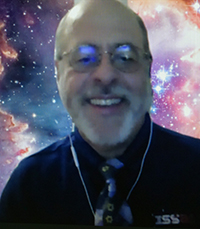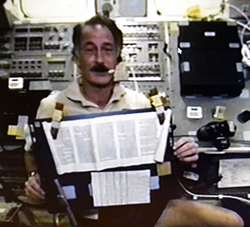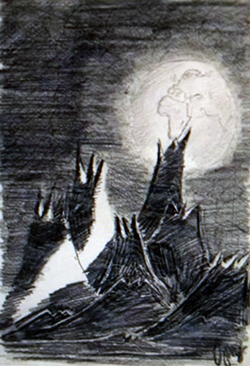By Donald H. Harrison


SAN DIEGO – Boris Volynov was first among approximately 19 Jews who have flown in space, serving as a Russian cosmonaut in 1969. Thereafter, Judy Resnik, Ilan Ramon and Gregory Chamitoff joined him in an exclusive club, being the first Jews from their nations to go into space. Resnik was from the United States, Ramon from Israel, and Chamitoff from Canada.
These were among the factoids presented by Roger Weiss, a NASA contractor on the International Space Station (ISS) program, in a Zoom program sponsored on Sunday, March 11, by the San Diego Outreach Synagogue. In 2017, Weiss was awarded the National Aeronautics and Space Agency’s (NASA) Exceptional Public Service Medal for leading research client service and satisfaction efforts in support of the International Space Station Program.

Weiss’s presentation focused on those space travelers who happened to acknowledge their Judaism in various ways during their separate missions. For example, Judith Resnik who like Ilan Ramon after her, died in an explosion of her spacecraft (Challenger 1984), made it known that she had attended Hebrew school in Akron, Ohio. She was recruited to the space program by Nichelle Nichols, who played Lt. Uhura in the original Star Trek series that featured such Jewish actors as William Shatner (Captain Kirk), Leonard Nimoy (Spock), and Walter Koenig (Chekov). Nimoy borrowed the split-fingered sign representing the Hebrew letter “shin” that is used by Jewish officiants in benedictions to create the Vulcan greeting “Live Long and Prosper.”

Dr. Jeffrey Hoffman was the first Jewish American man to fly in space, taking with him various ceremonial objects to help him observe Jewish holidays during his space flights. For example, he affixed a mezuzah to his bunk on the space craft Discovery, and that mezuzah reportedly is now a permanent exhibit at the Bloomfield Science Museum in Jerusalem. On a later flight on the space craft Endeavor, he brought along a dreidel to spin in honor of Chanukah. In 1996, he brought aboard the space craft Columbia a small Torah Scroll, pronounced a blessing, and then read the first line from B’reshit (Genesis 1) stating that God created the heavens and the earth. That “Space Torah” now is displayed at Congregation Or Ami in Houston, Texas, where Hoffman worshiped. Hoffman noted that astronauts have brought a great variety of objects with them to space to make them special.
Dr. David Wolf flew on the space craft Atlantis to Russia’s Mir space station, celebrating up there Rosh Hashanah, Yom Kippur and Chanukah. He quipped that it could have been the quickest Yom Kippur fast in history; it took his craft just 90 minutes to experience one Earth sunset to the next. Wolf also brought a dreidel to space.
Weiss, a member of Congregation Shaar Hashalom in Clear Lake, a waterfront residential district in southeast Houston, Texas, and home to the NASA/Johnson Space Center, mixed space history with a bit of shtick.
Garrett Reisman was the first Jewish resident of the International Space Station. Like Hoffman before him, he affixed a mezuzah to his bunk. He also brought along a copy of Israel’s Declaration of Independence given to him by Ilan Ramon’s widow, Rona, and from space sent well-wishes to Israel’s then-President Shimon Peres on the occasion of the 60th anniversary of Israel Independence.

Ramon, who died in the 2003 breaking aprt of the space craft Columbia, was the first astronaut to request kosher food in space. He brought with him a kiddush cup and a Torah that had survived the Bergen Belsen concentration camp. He also brought with him a copy of a drawing by Petr Ginz, an inmate who died in the Terezin Concentration Camp, that pictured what the earth might look like from the moon.
Although Ramon’s artifacts were destroyed, amazingly 18 pages of his personal diary were recovered from wreckage that was scattered over the Texas landscape. An Israeli Air Force flag also was recovered.
Jewish American astronaut Ron Garan subsequently carried a patch symbolizing Ramon’s flight, and non-Jewish astronaut Steve MacLean carried in Ramon’s memory a small Torah similar to the one the Israeli astronaut had carried. Another non-Jewish astronaut, Drew Feustel, brought along another copy of the Peter Ginz drawing provided to him by the Yad Vashem Holocaust Memorial in Jerusalem.
Jessica Meir in 2019 and 2020 became the first Jewish woman to become a long-time resident of the International Space Station and participated in the first all-female space walk. In 2019, she happily displayed her colorful Chanukah socks.
Weiss noted that a space probe created by SpaceIL, a private Israeli company, is named Beresheet and that the company plans to name its next probe Beresheet 2. He also reported that Eytan Stabbe, who served in the Israeli Air Force under Ramon, is slated to become the next Israeli in space in a planned private flight,
Weiss reported that Jessica Meir is among 18 people – 9 men and 9 women – who are training for NASA’s Artemis program, in which a woman and the next man will be landed on the moon in the years ahead.
*
Donald H. Harrison is editor of San Diego Jewish World. He may be contacted via donald.harrison@sdjewishworld.com Photos are from the Zoom Cast and from Roger Weiss’s slide and video presentation.